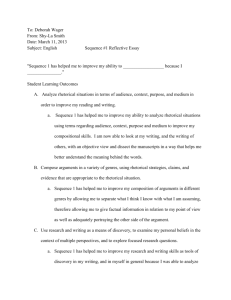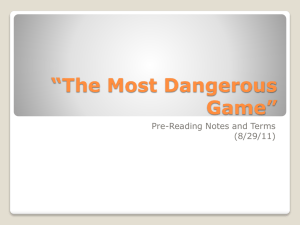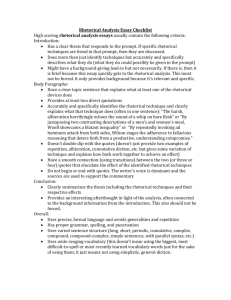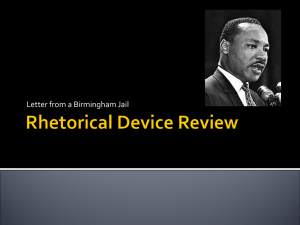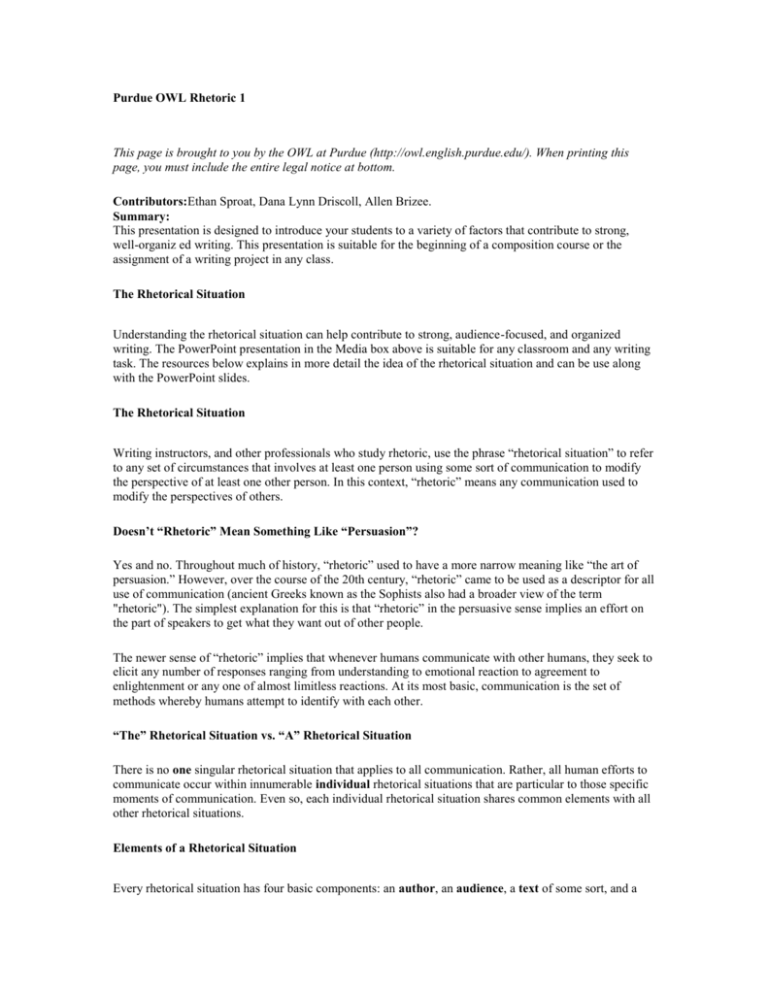
Purdue OWL Rhetoric 1
This page is brought to you by the OWL at Purdue (http://owl.english.purdue.edu/). When printing this
page, you must include the entire legal notice at bottom.
Contributors:Ethan Sproat, Dana Lynn Driscoll, Allen Brizee.
Summary:
This presentation is designed to introduce your students to a variety of factors that contribute to strong,
well-organiz ed writing. This presentation is suitable for the beginning of a composition course or the
assignment of a writing project in any class.
The Rhetorical Situation
Understanding the rhetorical situation can help contribute to strong, audience-focused, and organized
writing. The PowerPoint presentation in the Media box above is suitable for any classroom and any writing
task. The resources below explains in more detail the idea of the rhetorical situation and can be use along
with the PowerPoint slides.
The Rhetorical Situation
Writing instructors, and other professionals who study rhetoric, use the phrase “rhetorical situation” to refer
to any set of circumstances that involves at least one person using some sort of communication to modify
the perspective of at least one other person. In this context, “rhetoric” means any communication used to
modify the perspectives of others.
Doesn’t “Rhetoric” Mean Something Like “Persuasion”?
Yes and no. Throughout much of history, “rhetoric” used to have a more narrow meaning like “the art of
persuasion.” However, over the course of the 20th century, “rhetoric” came to be used as a descriptor for all
use of communication (ancient Greeks known as the Sophists also had a broader view of the term
"rhetoric"). The simplest explanation for this is that “rhetoric” in the persuasive sense implies an effort on
the part of speakers to get what they want out of other people.
The newer sense of “rhetoric” implies that whenever humans communicate with other humans, they seek to
elicit any number of responses ranging from understanding to emotional reaction to agreement to
enlightenment or any one of almost limitless reactions. At its most basic, communication is the set of
methods whereby humans attempt to identify with each other.
“The” Rhetorical Situation vs. “A” Rhetorical Situation
There is no one singular rhetorical situation that applies to all communication. Rather, all human efforts to
communicate occur within innumerable individual rhetorical situations that are particular to those specific
moments of communication. Even so, each individual rhetorical situation shares common elements with all
other rhetorical situations.
Elements of a Rhetorical Situation
Every rhetorical situation has four basic components: an author, an audience, a text of some sort, and a
context in and through which each situation occurs. All of these terms (author, audience, text, and context)
are fairly loose in their definitions and all of them affect each other. Also, all of these terms have specific
qualities that affect they ways that they interact with the other term. Below, you’ll find basic definitions of
each term, a brief discussion of the qualities of each term, and then finally, a series of examples which
illustrate various rhetorical situations.
Author
“Author” is a fairly loose term used to refer to anyone who uses communication. An author could be one
person or many people. An author could be someone who uses writing (like in a book), speech (like in a
debate), visual elements (like in a TV commercial), audio elements (like in a radio broadcast), or even
tactile elements (as is used in making Braille) to communicate.
Whatever authors create, authors are unavoidably human beings whose particular activities are affected by
these general constraints: authors have specific purposes that guide their actions in communicating, authors
have specific attitudes which affect what and how they communicate, and authors have specific
backgrounds that inform the nature of their communication.
Author’s Purpose
Authors’ purposes in communicating determines the basic rationale behind other decisions authors make
(such as what to write or speak about, what medium to use, etc.). An author’s purpose in communicating
could be to instruct, persuade, inform, entertain, educate, startle, excite, sadden, enlighten, punish, console .
. . you get the idea. Authors’ purposes are only limited to what each author wants to accomplish in his or
her communication. There are as many purposes for communicating as there are words to describe those
purposes.
Author’s Attitude
Attitude is a much overlooked element of rhetorical situations, but it affects a great deal of how a rhetorical
situation unfolds. Consider if an author communicates with a flippant attitude as opposed to a serious
attitude, or with drama as opposed to comedy, or calmly as opposed to excitedly. Depending on authors’
purposes, audiences’ specific qualities, the nature of the context, and other factors, any of these attitudes
could either help or hinder authors in their efforts to communicate depending on the other factors in any
given rhetorical situation.
Author’s Background
Many factors affect authors’ backgrounds. These can include age, personal experience, gender, location,
ethnicity, political beliefs, parents, peers, level of education, and others. Authors’ backgrounds affect the
things that authors assume about the world, their audiences, what and how they communicate, and the
context in which they communicate.
Contributors:Ethan Sproat, Dana Lynn Driscoll, Allen Brizee.
Summary:
This presentation is designed to introduce your students to a variety of factors that contribute to strong,
well-organiz ed writing. This presentation is suitable for the beginning of a composition course or the
assignment of a writing project in any class.
The Rhetorical Situation: Audience and Text
Audience
Like the term “author,” the term “audience” can also be loosely defined. “Audience” refers to any recipient
of communication. Audiences can read, hear, see, or feel different kinds of communication through
different kinds of media. Also like authors, audiences are unavoidably human beings whose particular
activities are also affected by specific purposes, specific attitudes, and specific backgrounds.
Audience’s Purpose
Like authors, audiences have varied purposes for reading, listening to, or otherwise appreciating pieces of
communication. Audiences may seek to be instructed, persuaded, informed, entertained, educated, startled,
excited, saddened, enlightened, punished, consoled. . . again, you get the idea.
Audience’s Attitude
Like authors, audiences bring diverse attitudes to how they appreciate different pieces of communication.
Their attitude while reading, listening, observing, or whatnot affects how they receive and process the
communication they receive.
Audience’s Background
And, also like authors, audiences’ individual backgrounds are affected by the same sorts of factors that
affect authors’ backgrounds. Most importantly, these factors affect how audiences receive different pieces
of communication, what they assume about the author, and the context in which they hear, read, or
otherwise appreciate what the author communicates.
Text
The word “text” is probably the most fluid term in a rhetorical situation. Usually, the word “text” refers to a
written or typed document. In terms of a rhetorical situation, however, “text” means any form of
communication that humans create. Whenever humans engage in any act of communication, there is a text
that serves as the vehicle for communication. Three basic factors affect the nature of each text: the medium
of the text, the tools used to create the text, and the tools used to decipher the text.
Medium of the Text
Texts can appear in any kind of medium, or mechanism for communicating. The plural of medium in this
sense is media. Various media affect the ways that authors and audiences communicate. Consider how
these different types of media can affect how and what authors communicate to audiences in various
rhetorical situations: hand-written, typed, computer-generated, audio, visual, spoken, verbal, non-verbal,
graphic, pictorial, tactile, with words, or without words (there are many others, of course).
Some varied specific examples of media could include a paper, a speech, a letter, an advertisement, a
billboard, a presentation, a poster-board, a cartoon, a movie, a painting, a sculpture, an email, a Twitter
tweet, a Facebook page or wall post, a conversation (face-to-face, on a cell phone, via text messages),
graffiti. . . this list goes on and on and is nearly endless.
Tools to Make the Text
Every text is made with tools that affect the structure and content of a text. Such tools could be physical
tools that range from very basic (such as the larynx, throat, teeth, lips, and tongue necessary for verbal
communication) to very complex (such as a laptop computer with graphic-manipulating software). These
tools could also be more conceptual tools that range from simple (such as implementing feedback from an
instructor) to more complicated (such as implementing different kinds of library and primary research). The
tools of communication often determine the kinds of communication that can happen in any given
rhetorical situation.
Tools to Decipher the Text
Likewise, audiences have varied tools for reading, viewing, hearing, or otherwise appreciating various
texts. These could be actual physical tools that would likewise range from very basic (like the eyes and
reading glasses necessary to read) to very complex (like a digital projector and screen to view a PowerPoint
presentation). Or they could be conceptual tools that could range from simple (childhood principles learned
from parents) to more complicated (a Master’s Degree in Art). The tools that audiences have at their
disposal affect the ways that they appreciate different texts.
Contributors:Ethan Sproat, Dana Lynn Driscoll, Allen Brizee.
Summary:
This presentation is designed to introduce your students to a variety of factors that contribute to strong,
well-organiz ed writing. This presentation is suitable for the beginning of a composition course or the
assignment of a writing project in any class.
The Rhetorical Situation: Context, Environment, Setting
Lastly, every rhetorical situation occurs in specific contexts, environments, or settings. The specific
constraints that affect a context include the time of both author and audience, the place of both author and
audience, and the community or conversation that authors and/or audiences engage in.
Time
“Time” in this sense refers to specific moments in history. It is fairly common knowledge that different
people communicate differently depending on the time in which they live. Americans born in the 1950s,
overall, communicate differently than Americans in the 2000s. Not that these folks necessarily speak a
different language, but these two groups of people have different assumptions about the world and how to
communicate based on the era in which they live.
Different moments in time can be closer together and still affect they ways that people communicate.
Certainly, scientists discussed physics somewhat differently the year after Einstein published his theory of
relativity than they did the year before Einstein published his treatise. Also, an author and audience may be
located at different times in relation to one another. Today, we appreciate Shakespeare’s Hamlet a bit
differently than the people who watched it when it first premiered four hundred years ago. A lot of cultural
norms have changed since then.
Place
Similarly, the specific places of authors and their audiences affect the ways that texts are made and
received. In an academic conference or lecture hall or court case, the place is a specific room. In other
rhetorical situations, the place may be the pages of an academic journal in which different authors respond
to one another in essay form. And, as mentioned with the authors’ and audiences’ backgrounds, the places
that audiences and authors are individually from affect the ways that different texts are made and received.
Community / Conversation
In various rhetorical situations, “community” or “conversation” can be used to refer to the specific kinds of
social interactions among authors and audiences. Outside of speaking about rhetorical situations,
“community” usually means specific groups of people united by location and proximity like a
neighborhood; and “conversation” usually means a fairly intimate occasions of discussion among a small
number of people.
But in regard to rhetorical situations, both of these terms can have much larger meanings. In any given
rhetorical situation, “community” and “conversation” can refer to the people specifically involved in the act
of communication. For instance, consider Pablo Picasso who used cubism to challenge international notions
of art at the time he painted. Picasso was involved in a world-wide “community” of artists, art critics, and
other appreciators of art many of whom were actively engaged in an extended “conversation” with differing
assumptions about what art is and ought to be.
Sometimes, authors and audiences participate in the same community and conversation, but in many
instances, authors may communicate in one community and conversation (again, think of Shakespeare four
hundred years ago in England) while audiences may participate in a different community and conversation
(think of contemporary literary scholars in any other country in the world who discuss and debate the
nature of Shakespeare’s plays). The specific nature of authors’ communities and conversations affect the
ways that texts are made while the specific nature of audiences’ communities and conversations affect the
ways that texts are received and appreciated.
Contributors:Ethan Sproat, Dana Lynn Driscoll, Allen Brizee.
Summary:
This presentation is designed to introduce your students to a variety of factors that contribute to strong,
well-organiz ed writing. This presentation is suitable for the beginning of a composition course or the
assignment of a writing project in any class.
The Rhetorical Situation: Example 1
A lot of what was covered above may still seem abstract and complicated. To illustrate how diverse kinds
of texts have their own rhetorical situations, consider the following examples. First, consider a simple (and
fictional) grocery list. Identifying the basic components of author, audience, text, and context reveals that
even a simple text like a grocery list has its own specific rhetorical situation.
Author
Let’s say that this particular list is written by an elderly retired woman who sends her husband on an errand
to the grocery store. She gives him a list of things to buy.
Author’s Purpose
Her purpose in writing the list are straightforward. She wants to make sure that her husband does not forget
anything that she sends him to the grocery store to buy.
Author’s Attitude</p>
Her attitude while writing the list is direct and serious. She doesn’t want him to forget anything!
Author’s Background
Her background includes a few decades of marriage to her husband and all the experience (from her
perspective) that suggests to her that she needs to give him a list to make sure he doesn’t forget anything.
Audience
The audience for this grocery list is the author’s husband who is an elderly retired man. He runs errands for
his wife on occasion.
Audience’s Purpose
This particular man wants to buy the groceries quickly. While he does not mind running errands for his
wife (and wants to be the kind of man who does nice things for his wife), he wants to hurry back and watch
a ball game on television.
Audience’s Attitude
This man’s attitude is slightly annoyed because he might miss the start of his game.
Audience’s Background
Similar to his wife’s background, this husband has a few decades married to his wife and all the experience
(from his perspective) that tells him he doesn’t really need the list his wife wrote him.
Text
The text is the grocery list itself.
Medium of the Text
The grocery list is a handwritten list of five items. The list reads, “1% milk, whole wheat bread, non-fat
grated mozzarella cheese, cookies for the grandkids (you decide), 8 bananas.” Notice how the varying
specificity reflects the woman’s varying attitudes of seriousness about what her husband buys. She is
specific about everything except the cookies which she is fine with letting her husband decide.
Tools to Make the Text
The grocery list is written on the back of an old receipt in black ballpoint pen ink. She writes small to get
the whole list on the back of the receipt. She relies on her years with her husband to know other specifics
that are otherwise omitted from the list (e.g. whether he should get a quart or gallon of milk or whether he
should get one or two loaves of bread).
Tools to Decipher the Text
The husband carries along his reading glasses, but even still has difficulty reading the small handwriting on
the grocery list. The husband also relies on the conceptual tools he’s developed over decades of marriage to
his wife. For instance, he knows that there is no more milk in the refrigerator at home, so of course he
should buy a whole gallon of milk.
Context / Environment / Setting
Time
Let’s say this grocery list was written a year or so ago.
Place
It was written in the small home of the retired couple in Seattle, Washington, USA. It was thrown away in a
garbage can outside the grocery store while the husband carried the few groceries back to the car.
Community / Conversation
The community and conversation is narrow and intimate including only the elderly retired woman and her
husband. . . that is unless someone different finds the list and discusses it with someone else. At that point,
a different community and conversation has begun discussing the text.
Contributors:Ethan Sproat, Dana Lynn Driscoll, Allen Brizee.
Summary:
This presentation is designed to introduce your students to a variety of factors that contribute to strong,
well-organiz ed writing. This presentation is suitable for the beginning of a composition course or the
assignment of a writing project in any class.
The Rhetorical Situation: Example 2
One of the most common rhetorical situations that people reading this will face or have faced is a research
paper for some sort of class. Consider the following fictional example of the rhetorical situation
surrounding a research paper.
Author
The author for this research paper is a 19-year-old female university student from China who is attending
her first year of classes at Purdue University in Indiana, USA.
Author’s Purpose
She has a few different purposes for writing this paper. First and foremost, writing this paper is a class
requirement and she must do well on it to get a good grade in the class. Secondly, she has chosen to write
her paper about a hydroelectric dam near her home in China because she feels strongly about clean,
hydroelectric power. Thirdly, she feels she needs continued practice writing in English (which is not her
first language), so she looks forward to the feedback she’ll get from her instructor in hopes she can improve
the way she writes.
Author’s Attitude
Her attitude is hopeful and earnest as she writes the paper. But she is also worried because she fears she
may not have enough mastery of the English language to write the paper well.
Author’s Background
She is from China. She struggles at times with a lot of the mechanical issues of written English. She is an
only child. She is studying Agricultural Engineering. All this has affected how and what she writes.
Audience
There are two audiences for this paper. The primary and most immediate audience for this paper is the
student’s instructor. Her instructor is a 25-year-old female PhD student from New Mexico, USA, studying
in English at Purdue University. This instructor teaches the first-year writing course that the student is
writing the research paper for. The student also hopes that she can eventually develop her paper into a
conference presentation, so she writes her paper with both her instructor and a future conference audience
in mind.
Audience’s Purpose
The instructor wants the student to master certain writing processes and principles and will be reading the
paper with these concerns in mind. The future conference audience will likely want to hear more about the
impact of different energy sources on the environment.
Audience’s Attitude
The instructor retains a helpful but expert attitude toward the student’s paper. The future conference
audience fosters an interested and egalitarian attitude toward the student’s presentation. Notice how each of
these attitudes can affect the way that the student’s research is received.
Audience’s Background
The instructor has previous experience working with students whose first language is not English. The
future conference audience will have had immediate background in the other presentations at the
conference.
Text
The text in this example is a 12-page research paper that argues for more efficient ways of harnessing
hydroelectric power. The paper uses the Xiaolangdi Dam on the Yellow River in China as an example of
what could be done better. Alternately, when she prepares her paper to present at a conference, the text at
the future conference would be her actual verbal presentation and any presentation aids she chooses to use
(such as a Power Point or a handout).
Medium of the Text
As a paper for class, the medium is a stack of twelve computer-typed white sheets of paper. As a
conference presentation, the medium is her spoken voice accompanied with a digital Power Point display.
Tools to Make the Text
As a paper for class, the student uses a computer with a word processing program to actually type the
paper. Using a computer not only makes the paper neat and readable, but it is also required. The actual
physical tool used to write the text greatly affects how the text is received. She also uses the conceptual tool
of research that she’s learned in class to help her find the material she needs. As a conference presentation,
the student uses a computer and a digital projector to display the necessary images at her presentation. She
also uses the conceptual tools of public speaking that she learned in her first-year Communication and
Speech course at Purdue University.
Tools to Decipher the Text
As a paper for class, the instructor uses the same paper that the student gave her. She also uses the
conceptual tools she’s learned in her studies as a PhD student to help her grade the paper and give
feedback. As a conference presentation, the future audience makes use of the same digital projector and a
screen that the student uses to present. The digital projection of the student’s power point slides helps
convey her ideas quickly and efficiently in the limited time she was to present. The range of conceptual
among the conference audience tools will be greater as people in the audience will have different levels of
education and experience.
Context / Environment / Setting
Because of the split nature of the student’s purposes, the context for the paper are split as well.
Time
As a research paper, the text is situated within the fifteen-week structure of a typical American university
semester. Also, the student’s research about hydroelectric dams and the Xiaolangdi Dam in particular
reflect the most current information she can locate. When she presents her research at a conference a year
or two later, she will need to make sure her research is still up-to-date.
Place
As a research paper, the text occurs within the confines of the curriculum of the student’s first-year writing
class. As a conference presentation, the text occurs within the specific confines of a presentation room at an
academic conference.
Community / Conversation
As a research paper, the student’s text is part of a small conversation between her and her instructor in the
small community of a first-year writing class. As a conference presentation, the community and
conversation of her text got substantially larger: the community and conversation possibly involve a worldwide community of engineering and agricultural experts, researchers, and professionals.
Contributors:Ethan Sproat, Dana Lynn Driscoll, Allen Brizee.
Summary:
This presentation is designed to introduce your students to a variety of factors that contribute to strong,
well-organiz ed writing. This presentation is suitable for the beginning of a composition course or the
assignment of a writing project in any class.
The Rhetorical Situation: Conclusion
The preceding examples serve to illustrate some of the range of circumstances in which rhetorical situations
can be found. But, really, rhetorical situations occur whenever one person attempts to communicate with
another person. We could do the same activity with a painting, a work of fiction, a political debate, a film, a
Facebook status update, a squabble between lovers, a personal journal entry, or any other act of
communication.
Invariably, all situations involving communication involve at least one of each of the following:
1. an author with specific purposes, attitudes, and background;
2. an audience with equally specific purposes, attitudes, and background;
3. a text in a particular medium, made with certain tools, and deciphered with certain tools; and
4. a context in a particular time and place involving a certain community and conversation.
Understanding the factors that shape rhetorical situations make authors and audiences more aware of what
goes into different acts of communication. Overall, understanding these factors helps people better
understand the differing perspectives of others.
Copyright ©1995-2010 by The Writing Lab & The OWL at Purdue and Purdue University. All rights
reserved. This material may not be published, reproduced, broadcast, rewritten, or redistributed without
permission. Use of this site constitutes acceptance of our terms and conditions of fair use. Please report
any technical problems you encounter.

